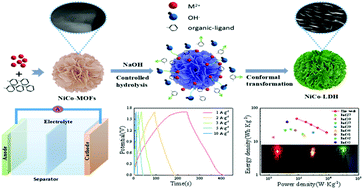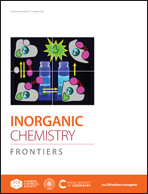Synthesis of 3D flower-like hierarchical NiCo-LDH microspheres with boosted electrochemical performance for hybrid supercapacitors†
Abstract
Hybrid supercapacitors (HSCs) have aroused considerable attention by virtue of their high ionic conductivity and operation voltage. In this study, three-dimensional (3D) flower-like hierarchical NiCo layered double hydroxide (LDH) microspheres are synthesized via a simple and gentle alkaline hydrolysis strategy. Compared with MOF precursors, the obtained NiCo-LDH microspheres could maintain their initial morphology and possess a more uniform pore structure with a higher specific surface area which are suitable for supercapacitors. By regulating the alkali concentration, it is found that an optimal electrochemical performance is obtained with high specific capacitance (1750.0 F g−1 at 1 A g−1) and superior cycling durability (retaining 91.0% after 3000 cycles) when the alkaline concentration is 1 mol L−1. Subsequently, NiCo-LDH//AC HSC assembled by combining NiCo-LDH with activated carbon (AC) achieves a maximum energy density of 48.6 W h kg−1 when the power density is 850 W kg−1 and equipped with remarkable cycle durability (maintaining 92.3% after 5000 cycles). These incredible electrochemical properties are mainly ascribed to the exceptional hierarchical structure, porosity and specific surface area, contributing to facilitate the rapid transmission of electrons and ions. The alkali hydrolysis strategy provides a new choice for the preparation of high-efficiency electrode materials and the design of hybrid supercapacitors.

- This article is part of the themed collection: 2021 Inorganic Chemistry Frontiers HOT articles


 Please wait while we load your content...
Please wait while we load your content...